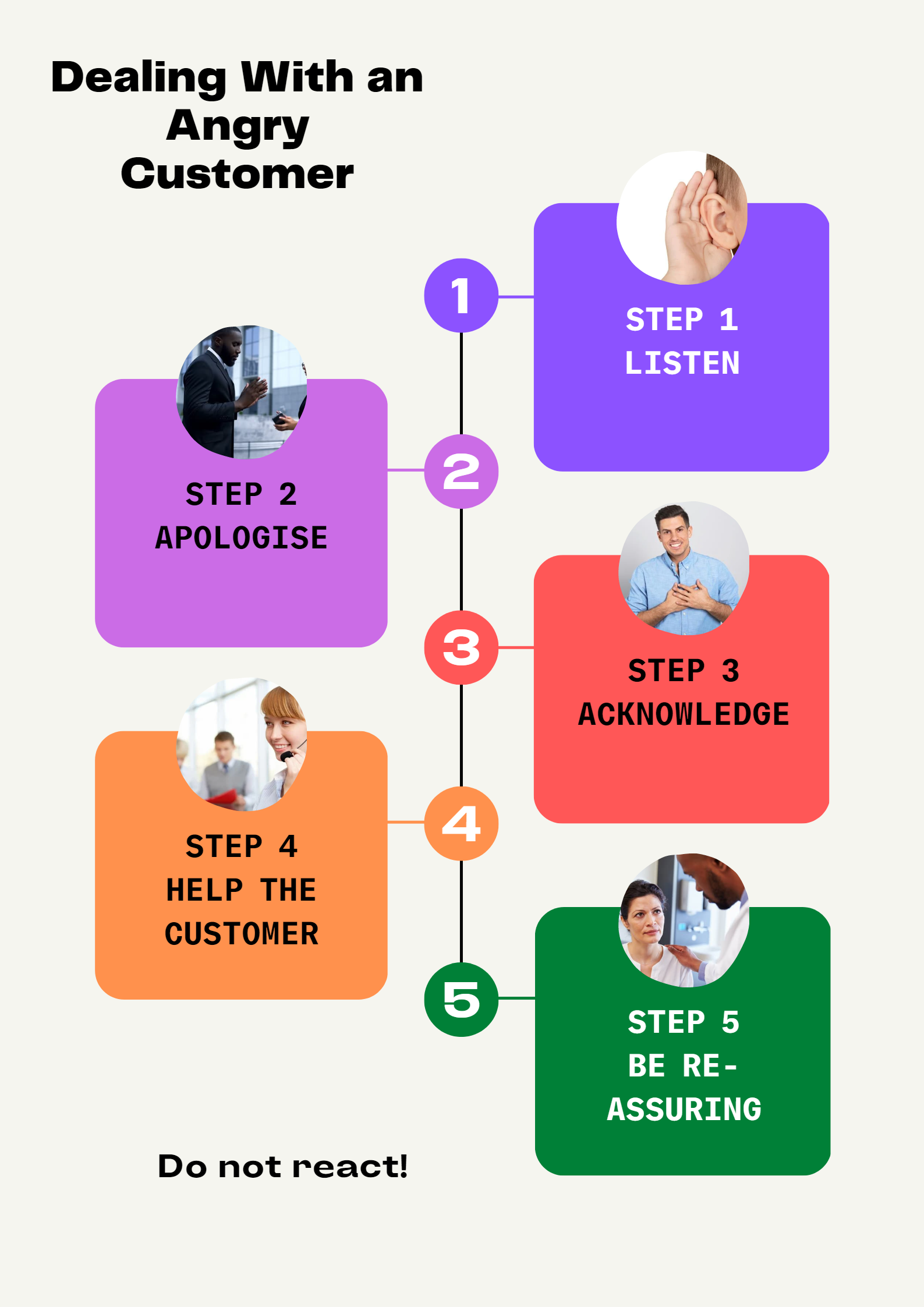Click here to view a video that explains the eight tips and examples to deal with angry customers.
There are five basic steps you should follow in handling a complaint:

Step 1 – Listen
Listen completely to the request or complaint. Don’t interrupt the customer. Hear him out. Sometimes it makes people feel better just to have someone to listen, an opportunity to “get things off my chest.” Listening without interrupting also improves your chances of getting all the facts concerning the request or complaint.
Often, when an angry customer is first explaining the situation, he or she will express feelings without giving much detail about exactly what the problem is. This is normal. Human beings often need to release feelings before they are calm enough to get to the facts. Allow your customer to express his emotions without feeling threatened.
When you recognise that the customer has finished expressing emotions about the problem, DO NOT respond by asking for facts. An angry customer needs to be assured that you understand how he feels before he will have confidence in you to take a personal interest in his query or complaint.
You can acknowledge your customer’s feelings by saying something like, “I don’t blame you at all for being upset” or “I can certainly understand why you are frustrated with this problem.”
Once the customer believes that you have listened and you understand, he will be much more willing to let you develop the facts you need to deal with his request or remedy the problem.
When you do begin to gather the facts, get all the facts and write them down!
Step 2 – Apologise
An apology is always appropriate when a customer is angry, regardless of whose fault it is. You must let the customer know that you, as the representative of your company, are sorry that we, as a company, have failed to meet his expectations.
There will be times when customers will be angry or upset about things you have no control over. In these situations, you will still need to let the customer know that you are sorry that he is angry. But you should not feel apologetic for company practices that are in place to ensure the highest standards of service and integrity. Handle that type of complaint something like this:
“I’m sorry you’re angry about the rate increase and I’d like to explain a little bit more about it.”
Avoid misleading the customer into thinking things will change in circumstances such as these. It’s better to apologise and offer an explanation than to sidestep the confrontation by sounding “wishy-washy.”
Step 3 – Acknowledge
Acknowledge the customer’s specific request or complaint. Paraphrase back to the customer the reason for his dissatisfaction (don’t repeat word for word). This demonstrates to the customer that you are indeed listening. This allows the customer to correct you if by some chance you have misunderstood the nature of the problem.
Step 4 – Help the Customer
Help the customer by:
- Giving explanations
- Telling what you can do
First, if the company has made an error (it can happen), admit it! Tactfully explain what went wrong and tell what you can do to correct the situation. There may be times, however, when you are unable to resolve the customer’s complaint. In these cases, you should explain why you are unable to do so. Be firm, but tactful. Show understanding of the customer’s dilemma. If appropriate, offer a solution to prevent the same or similar problem from happening again.
If, by this point in your contract, your customer has not calmed down, consider alternative ways for handling the rest of the call. The customer may need more time to get his emotions under control or he may need to talk with another person who can try a different approach.
Step 5 – Be Re-assuring
When you can help, make sure the customer understands that you are able and willing to help him now. Use the words, “I can help you”, although you may have said it earlier. An extremely angry customer may not have even heard you.
Use a calm and confident tone of voice. Don’t allow yourself to become as excited as the customer probably is.
Click here to view a video that explains how to handle customer complaints by defusing frustration.